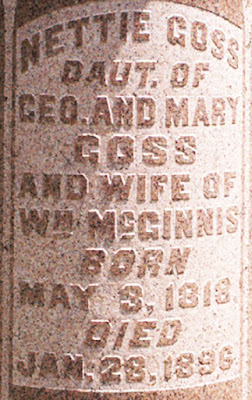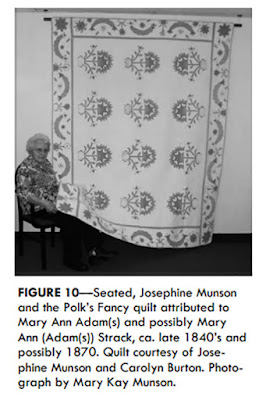Between 1840 and 1870 American quiltmakers developed a wide variety---thousands---of applique florals. We could describe them as formally symmetrical with 4-way-mirror image symmetry or two-way symmetry as in the flower pots. The names of most of the patterns (if they ever had specific names) are unknown today. In the sampler above we might find patterns we could call a Strawberry Wreath, a Cherry Wreath, an Eagle and several "Appliqued Baskets."
These pots in their wide variety usually feature symmetrical bouquets of
appliqued botany, such as the grapes and pomegranate fruits
and 8-lobed flowers.
Pennsylvania basket in a summer spread from my collection
Museum of the Rockies Collection, attributed to Priscilla Cornell.
But here's an exception in two ways.
1) The floral is partially pieced of diamonds (parallelograms), related to the common 8-pointed star.2) We know of a period name.
Ileana Villazon recently posted this photo on our QuiltHistorySouth page.
Did the pattern have a name?
Indeed it did, responded folklorist Teri Klassen of Indiana who has
studied this design called Polk's Fancy. At the bottom here see links to her
publications from which several of the captions are copied.
Janice Harrell bought this quilt in Brown County Indiana. Looks
1880-1930 by the way the greens are fading and the simplicity of the set.
See her maiden name initials "N.G." inscribed in the top border with the date 1846. The maker's son John (1861-1941) thought it was named "Polk's Fancy."
We do not often find such evidence of mid-19th-century quilt names in museum records but John's memory would seem to be a good indication that Nettie Goss called her quilt "Polk's Fancy."
1860 Census, Vernon Township, Washington County, Indiana
Pages have faded but we can make out William and Nettie who is 42 years old
with four boys under 6. Eldest Horace was born in May, 1854. She
married in 1853 changing her initials from NG to NM.
1880 census in Jackson Township, Washington County
Nettie, husband William and 6 sons on their farms.
"As best I can tell, the pattern originated in south central Indiana around the time Polk was running for president [1844] and led the country through the Mexican-American War [1846-48]. I know now of Polk's Fancy quilts in several other states, but in cases where I could trace provenance, they all led back to southern Indiana."
When Teri wrote her first paper on the name she had seen five quilts in the distinctive design. Now we have pictures of 22.
Almost identical quilt by Elizabeth Jane Goss Martin (1833-1907) with her maiden initials EJG at the bottom here. Elizabeth, a relative of Nettie's father, married in 1850.
The blue-green shows typical damage found in Prussian blue solids where a brown stain migrates out from the blue.
These quilts are mirror-image versions as you can see
when the McGinnis quilt photo is flipped so the NG letters are reversed.
Cindy Rennels had this quilt in her inventory:
Quilt Teri found in Martinsville, Indiana.
The dealer didn't remember where he'd found it
but had bought items in Washington County.
An interesting diagonal set in which the blocks in
the middle row are rotated, something we see in the next quilt too.
Quilt attributed to Ethel Bertha Mount (1898-1985).
Ethel may have made it or commissioned it from a professional quiltmaker in the 1920s
as a copy of a family quilt. Strip borders rather than applique are more typical of the years
after 1880.
Photo courtesy of Martha Spark
Sarah Souder Johnson (1829-1913) Washington County, Indiana. The quilt has been cut down.
Photo of a Four-Block from our much-missed friend Cinda Cawley.
Cinda wrote a note in 2007:"I think I have one of your Polk's Fancy quilts. I bought it at the Sully (Chantilly, VA) Quilt Show in 2005. The dealer had no information other than that she had bought it at auction in Lebanon, OH--not far from where the Indiana quilts were made."
By 2007 Teri had identified a few more quilts in the pattern for the article in the Indiana Genealogist.
Much of the Turkey red fabric has worn away, as it tends to do.
Teri's 2006 paper: "Polk's Fancy: Quiltmaking, Patriotism, and Gender in the Mexican War Era," Uncoverings 2006. Here's a link to the text at the Quilt Index. No pictures though.
https://quiltindex.org/view/?type=publications&kid=35-90-299
"Tracing the Genealogy of a Southern Indiana Quilt Pattern," Indiana Genealogist, September, 2007.
Hope this link works:
https://scholarworks.iu.edu/dspace/bitstream/handle/2022/20558/INGen%20PF.pdf?sequence=1&isAllowed=y&fbclid=IwAR3s4qD8rlv_IUPP8LPMfdINiyyC81CRPtRWoEEoYHWCdu5SsppTu2xYLWk
Hope this link works:
https://scholarworks.iu.edu/dspace/bitstream/handle/2022/20558/INGen%20PF.pdf?sequence=1&isAllowed=y&fbclid=IwAR3s4qD8rlv_IUPP8LPMfdINiyyC81CRPtRWoEEoYHWCdu5SsppTu2xYLWk
And ask to join our QuiltHistorySouth Facebook page. We see some great quilts.




























No comments:
Post a Comment